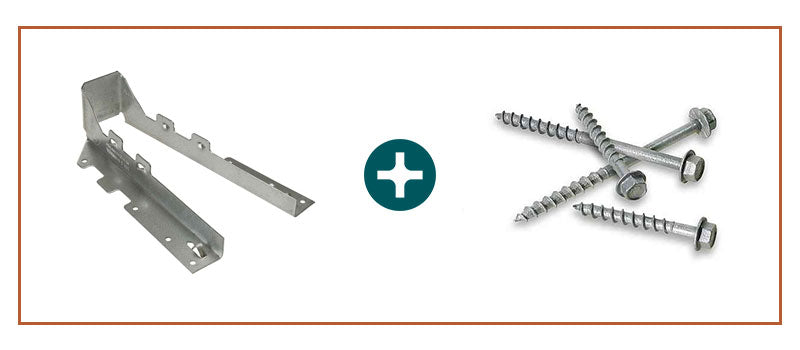
How to Install Deck Joist Hangers

When building a deck, joist hangers are very important. They do an excellent job keeping the deck safe and secure. With the use of heavy-duty fasteners, joist hangers transfer the vertical load on the joists to the ledger and the rim joists. Watch the video below to learn what joist hangers and fasteners are the right fit for your deck and how to install them correctly.
Why Use Joist Hangers
Joist hangers are connectors skillfully molded from steel. They create a strong connection between joist lumber, beams, or rim joists. This connection is much stronger than using screws or nails alone. These connectors are cost-effective and can be used for many small and large jobs.
Joist hangers commonly have a U shape to fit around three sides of the joist. Furthermore, lumber shrinks and twists as it dries and ages. They also do a great job of keeping the joists stable as they age.
Installing Joist Hangers
Listed below are the steps to take when installing joist hangers.
1. Begin by purchasing a joist hanger that is specified for the joist size you will be using for your deck. The most common joist lumber sizes are 2x8", 2x10", and 2x12". Next, purchase the screws or nails the manufacturer specifies for that particular hanger.
It is important to choose joist hangers and fasteners with corrosion-resistant finishes such as ZMAX or stainless steel.
2. Align the edge of the floor joist to the top of the rim joist. The placement of joists are typically 12-16" apart.
3. Once the joist is in the correct place, slide it under it to where it fits very tight. Make sure the joist is sitting square in the hanger. Hammer the prongs on the joist hanger to the rim joist. This temporarily sets your hanger in place.
4. Install the fasteners into the rim joist side first. The rim joist is the wood that butts up to floor joists and wraps around the perimeter of the deck. Rim joists are also referred to as band boards and rim boards. Hammer or drill the fasteners through the predrilled holes in the joist hanger. If the area is too tight for a hammer, a pneumatic hammer can be used.
5. Hammer or drill the screws through the holes in the hanger into the joist. Make sure all the fasteners are drilled in all the way.
For even simpler installation, the Hang Em' Fast joist hanger tool sets your 2x joist hangers perfectly every time. Just slide your hanger into the tool, line the tool up with your mark while the bottom lip of the tool is flush with the ledger board, and nail your hanger in.

Deck Joist Hanger Screws
A common mistake made when installing joist hangers to a deck is using the incorrect fasteners. Deck screws, drywall screws, and roofing nails should never be used when installing joist hangers. These fasteners are vulnerable to breaking under shear stress. They do not have the specified shear strength required. Joist hangers can be installed with screws but they need to be heavy-duty structural connector screws designed for this application.
The Simpson SD connector screws and Simpson SDS connector screws are ideal options. The SD screws are designed for lighter hangers while the SDS screws are designed for heavier hangers. The load values achieved by these connector screws exceed those of typical 10d and 16d common nails.
Deck Joist Hanger Nails
Nails can be used with joist hangers and provide great results. However, It is important to only use nails that the manufacturer specifies. The Simpson Strong Drive connector nails are designed to meet the requirements for specific joist hangers. Hot dip galvanized nails and stainless steel nails are available at Fasteners Plus.
Types of Joist Hangers
There are many different types of joist hangers to choose from. When considering which hanger is the right fit for you, there are several questions to consider. What are your load requirements? Do you want to use a top flange or a face-mount joist hanger? What type of lumber will you be using?
- Top-flange hangers- typically have higher down loads with fewer required fasteners. They must be installed where there is access to the top of the supporting member. These can also be installed before the joist is in place.
- Face-mount hangers- can be installed after the joist is in place. They often have higher uplift loads but require more fasteners for installation.

Corrosion Resistant Joist Hangers and Fasteners
Additionally, the environment where the hangers will be installed is another factor to consider. When building an outdoor structure, it is important to invest in joist hangers and fasteners that are corrosion-resistant. Using connectors that are stainless steel or have a ZMAX finish will help prevent corrosion.
Simpson Strong-Tie stainless steel joist hangers provide maximum corrosion resistance. They have superior performance in harsh environments and pair with stainless steel fasteners.
A joist hanger with a ZMAX finish also has great corrosion resistance and pair with the hot dip galvanized fasteners for the best performance.
Avoid Making These Mistakes
The Wrong Joist Hanger Size
Purchasing the wrong-sized joist hanger is a common mistake. Double check the hanger has the correct dimensions to fit your joists and is designed for the type of lumber you are using for your application. Different types of lumber require different joist hangers.
Check out this blog to learn more about the difference between nominal and rough-cut lumber and the proper hangers for each type of lumber.
Reshaping or Cutting Joist Hangers
In some situations, the joist doesn't fit the joist hangers due to the lumber size fluctuating. It is not recommended to modify the connector. Modifying the joist hanger can cause serious issues to the strength and reliability of your deck.
Not Filling all the Holes in the Joist Hanger
Not filling all the holes in the joist hanger is also a common mistake. It is essential for all the holes to be drilled to meet the load values.
Re-using Joist Hangers
Joist hangers are designed for one-time use to deliver the best performance. Reusing these connectors even if they appear to have no deformation, puts your structure at risk.






